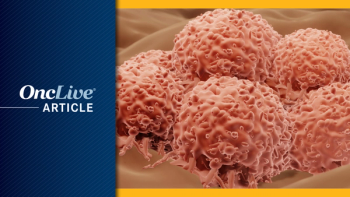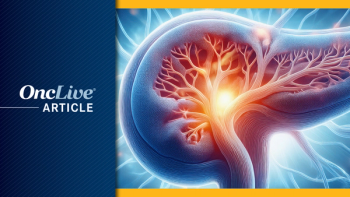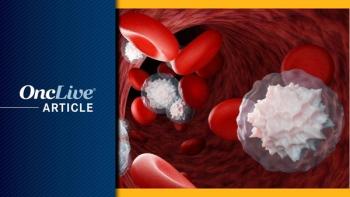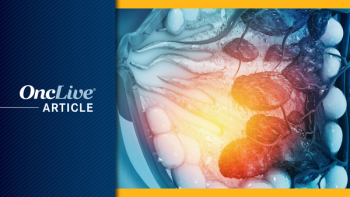
Copanlisib Plus Ibrutinib Produces High Response Rate in Relapsed/Refractory MCL, But Limited by Additive Toxicity

Although the addition of copanlisib to ibrutinib resulted in a high overall response rate in patients with relapsed/refractory mantle cell lymphoma, the regimen was found to have additive toxicity, according to findings from a small phase 1 trial.
Although the addition of copanlisib (Aliqopa) to ibrutinib (Imbruvica) resulted in a high overall response rate (ORR) in patients with relapsed/refractory mantle cell lymphoma (MCL), the regimen was found to have additive toxicity, according to findings from a small phase 1 trial (NCT03877055) published in Blood Advances.
At a median follow-up of 20 months (range, 8-20), all 8 patients included in the trial were determined to be evaluable for efficacy. Results showed that the doublet elicited an ORR of 87.5%, which included a complete response (CR) rate of 50% and a partial response rate of 37.5%. One patient who previously received ibrutinib experienced disease progression as their best response. Moreover, the median progression-free survival (PFS) with copanlisib plus ibrutinib was 7.7 months (95% CI, 2.7–not reached).
“Our study illustrates clinical outcomes with the PI3K alpha/delta inhibitor copanlisib and the BTK inhibitor ibrutinib in relapsed/refractory MCL. This combination was designed to inhibit B-cell receptor [BCR] signaling more thoroughly than ibrutinib alone, with the hope of achieving better outcomes in relapsed/refractory MCL,” study author David Qualls, MD, of the Lymphoma Service in the Department of Medicine at Memorial Sloan Kettering Cancer Center, and colleagues, wrote. “While a high ORR and CR were observed in this small cohort, responses were of limited duration, and the regimen was further limited by additive toxicity.”
MCL is known to be molecularly dependent on BCR signaling, and ibrutinib has been shown to be able to suppress an important mediator of the BCR pathway. Specifically, the BTK inhibitor has been found to produce ORRs that range from 67% to 77% in those with relapsed/refractory disease, but the depth of these responses has been limited. Complete remission rates have ranged from 21% to 38% with this agent, the median PFS is typically less than 18 months, and BTK resistance often occurs.
Investigators have hypothesized that inhibiting pathways such as the PI3K pathway might serve to prevent such resistance. In fact, in vitro studies that have evaluated BTK and PI3K inhibitors in combination have demonstrated synergistic cytotoxicity. Although novel combinations such as umbralisib (Ukoniq) plus ibrutinib and idelalisib (Zydelig) plus tirabrutinib (Velexbru) failed to show an efficacy benefit over ibrutinib monotherapy, they did showcase a tolerable safety profile. Conversely, the combination of buparlisib (BKM120) and ibrutinib produced an encouraging CR rate but resulted in additive toxicity that prohibited further evaluation.
Investigators hypothesized that the addition of the pan-PI3K inhibitor copanlisib, which has a specificity for alpha and delta isoforms, to ibrutinib would result in an improved response rate and produce more durable responses in patients with MCL.
To further evaluate this, the phase 1 trial was launched and enrolled a total of 8 patients with relapsed/refractory MCL who had previously received at least 1 line of therapy. To be eligible for enrollment, patients were required to have a favorable performance status and acceptable bone marrow and organ function.
Notably, participants were allowed to have previously received a BTK or PI3K inhibitor as long as their best response to treatment was stable disease or better.
Study participants received intravenous copanlisib on days 1, 8, and 15 of 28-day treatment cycles, and oral ibrutinib daily in 28-day cycles. The trial utilized a 3+3 scheme, where at dose level 1, patients received copanlisib at 45 mg and ibrutinib at 560 mg (n = 6); at dose level 2, patients received copanlisib at 60 mg and ibrutinib at 560 mg (n = 2). Treatment was administered for a maximum duration of 36 cycles and could not exceed 36 months.
Among those who achieved a CR to treatment per RECIL criteria, the pan-PI3K inhibitor was held following 2 additional cycles, and single-agent ibrutinib was continued.
The primary objective of the trial was to determine the maximum tolerated dose (MTD) and the recommended phase 2 dose. Key secondary objectives included CR rate within 6 months, ORR, PFS, and event-free survival.
All 8 patients had previously received at least 1 line of therapy, and 1 of these patients received prior ibrutinib. This specific patient had received the combination of bendamustine, rituximab (Rituxan), and ibrutinib in the frontline setting, experienced a CR, and then relapsed as they were receiving maintenance ibrutinib before enrollment to the trial.
The majority of patients were noted to have high-risk pathologic features such as blastoid or pleomorphic histology (62.5%), elevated Ki-67 proliferation index (75.0%), and TP53 aberrations (87.5%). The aberrations were observed in 5 of 7 patients at the time of their initial diagnosis; they were detected in 2 patients at the time of repeat biopsy before trial enrollment.
Additional data showed that after disease progression on the combination, 2 patients went on to receive CAR T-cell therapy and 1 went on to undergo allogeneic transplant.
In 7 of the 8 patients, minimal residual disease was detected by next-generation sequencing; this included all 4 patients who achieved a radiologic CR per RECIL criteria with the combination.
Investigators identified dose level 1 to be the MTD for the combination. The 2 patients who received dose level 2 experienced dose-limiting toxicities, which included grade 3 acute kidney injury that needed temporary ibrutinib interruption, as well as grade 3 rash which needed steroids and copanlisib/ibrutinib interruption. In the latter case, both drugs were resumed at reduced doses.
One patient who received the combination at dose level 1 experienced grade 3 mucositis that needed interruption; this patient resumed treatment at a lower dose and their symptoms improved.
Three patients experienced grade 3 rash and 2 patients had transient grade 3 diarrhea. One patient experienced hepatotoxicity and needed to discontinue treatment after 50 days on treatment; this patient resumed single-agent ibrutinib and did not continue to experience this effect. A total of 3 patients experienced asymptomatic cytomegalovirus (CMV) reactivation and did not need treatment; they also experienced spontaneous reversion to CMV negativity.
Notably, no treatment-related deaths were reported. However, 5 of the 8 patients experienced disease progression on the trial and subsequently died because of complications resulting from this progression. The remaining 3 patients were alive at the time of publication and 2 were still on treatment in accordance with trial protocol.
“A phase 2 cohort was initially planned with target accrual of 33 patients; however, due to poor accrual, toxicity, and the shifting treatment landscape for MCL, the study was closed early,” the study authors concluded.
Reference
Qualls D, Lam HYJ, Whiting K, et al. A phase 1 trial of copanlisib plus ibrutinib in relapsed/refractory mantle cell lymphoma. Blood Adv. Published online February 16, 2022. doi:10.1182/bloodadvances.2021006555

























































































